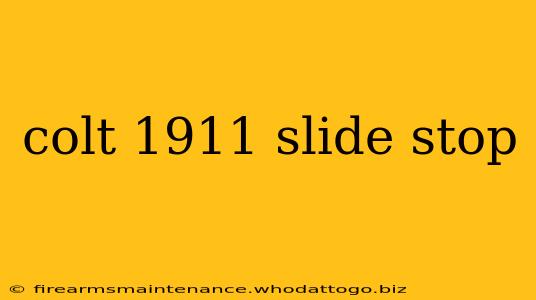The Colt 1911, a legendary handgun, relies on a series of precisely engineered components for reliable operation. Among these, the slide stop plays a crucial, often overlooked, role. Understanding its function, common problems, and solutions is essential for any 1911 owner, whether a seasoned shooter or a newcomer to this iconic platform.
Understanding the 1911 Slide Stop's Function
The slide stop on a Colt 1911 serves two primary functions:
- Locking the slide open: After the last round is fired, the slide stop engages with the slide, locking it to the rear. This allows for easy reloading and visual confirmation of an empty magazine.
- Releasing the slide: Depressing the slide stop allows the slide to move forward, chambering a new round. This is crucial for resuming firing or performing a tactical reload.
The slide stop's interaction with other components, specifically the slide and the magazine, is critical for its proper functioning. Any misalignment or wear can lead to malfunctions.
Common 1911 Slide Stop Problems
While generally robust, the 1911 slide stop can experience several issues:
1. Slide Stop Failure to Lock Open
This is a common problem and can stem from several sources:
- Weak spring: A worn or weak slide stop spring can prevent it from adequately engaging the slide, leading to failure to lock back on the last round.
- Damaged slide stop: Bent or damaged slide stops are unable to properly engage the slide.
- Magazine issues: A weak magazine spring or improperly seated magazine can prevent the slide stop from engaging.
- Excessive wear: Over time, wear on the slide stop, slide, or frame can compromise proper engagement.
2. Slide Stop Failure to Release
This issue, while less frequent than failure to lock open, is equally frustrating:
- Stiff spring: A new or excessively strong slide stop spring can make releasing the slide difficult.
- Damage or debris: Dirt, debris, or damage to the slide stop itself or its interaction points can hinder smooth release.
- Over-tightened grip: Excessive grip pressure can sometimes interfere with the slide stop's operation.
Troubleshooting and Solutions
Addressing these issues requires a methodical approach:
1. Inspecting the Slide Stop and Spring
Carefully examine the slide stop for any visible damage, bends, or excessive wear. Inspect the spring for signs of weakness or breakage. Replacement is often the solution for damaged or worn parts.
2. Checking the Magazine
Ensure the magazine is properly seated and that the magazine spring is functioning correctly. A weak magazine spring can prevent the slide from locking back reliably.
3. Cleaning and Lubrication
Thoroughly clean the slide stop and its interaction points with the slide and frame. Apply a light coat of high-quality gun lubricant to ensure smooth operation.
4. Considering Professional Help
If troubleshooting fails to resolve the issue, it's crucial to seek the assistance of a qualified gunsmith. Internal issues or frame/slide wear may require professional attention.
Maintaining Your 1911 Slide Stop
Preventative maintenance is key to reliable 1911 operation. Regular cleaning, lubrication, and inspection of the slide stop and associated components will significantly reduce the chances of malfunction. This diligent approach ensures your Colt 1911 remains a dependable and accurate firearm for years to come. Remember, a functional slide stop is not merely a component; it's an integral part of ensuring safe and reliable operation of your firearm.

